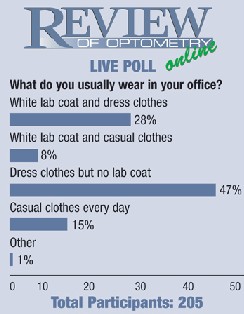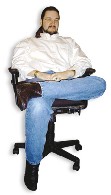Tradition holds that doctors ought to wear white lab coats. The white coat not only looks neat and professional, but also conveys a sense of clinical authority.

But the dress code is changing, at least for optometrists. Fewer than two out of five optometrists (36%) now wear a white coat on a daily basis, according to our online poll. Is it time for optometrists to take off that stuffy white coat?
What Patients Prefer
If the doctor is dressed nicely and wears half-decent shoes, I feel more confident in him, says optometrist and Chairside columnist Montgomery Vickers. In contrast, he says, Ive gone to doctors who are really casual, and you cant tell if hes the doctor or some guy from the waiting room.
Dr. Vickers may be well known for his messy desk but he always tries to dress neatly. He wears a tie and white lab coat in his St. Albans, W.Va., office. A professional appearance projects the doctors level of professionalism, he says.

If Montgomery Vickers, O.D., can wear a tie, why cant you?
Interestingly, doctors may be more demanding than patients when it comes to how doctors should dress. When doctors and patients opinions are compared, patients rate traditional itemslike the white coatless positively and casual items less negatively than doctors do.1
So what do your patients prefer you to wear? One study, which reviewed 31 other articles on this question, found that patients do indeed want their doctors to dress professionally, preferably in a white coat with a nametag.2 Patients tend to favor more formal dress, and give high ratings to a shirt and tie, dress pants, skirts or dresses, and dress shoes.
Patients give poor marks to a dressed down look. Many patients say they arent as comfortable with a doctor in sandals, shorts or jeans.
Male doctors with long hair and earrings also get low grades. Same goes for female doctors with long fingernails and dangling earrings.
White Coat Syndrome
Despite patient preference for the white coat, some patients have an involuntary physical reaction to a doctors office and treatment by someone in a white coatthe so-called white coat syndrome. These patients experience a psychosocial response that triggers a transient increase in blood pressure.3,4
Kids in particular can be scared by the white coat. To test this effect, optometrist Bernard Mallinger decided to ditch the white coat for awhile to see how his pediatric patients would react. Dr. Mallinger, who has a large childrens population in his Pittsburgh practice, is a self-professed old school optometrist who typically wears a white coat and bow tie.

What he found is that kids dont seem to care. Whether he wore the white coat or not didnt matter to his pediatric patients. So he put it back on and has kept it on since.
Indeed, the studies appear to agree with Dr. Mallingers observation.5 One study actually found that more than half of children (54%) actually prefer a doctor in a white coat.6 (More important to kids, though, was that the doctor wear a smile and have pictures of cartoon characters on the exam room wall.)
Dr. Mallinger, however, had some help in acquainting himself with kids. Over the years, he has appeared on three episodes of Mister Rogers Neighborhood. Fred Rogers was a patient and he showed his television audience that an optometrist such as Dr. Mallinger was no one to be afraid of.
Even to children, though, the doctor must present a wholesome appearance, down to polished shoes and clean fingernails, Dr. Mallinger says. After all, youre providing health care, and you really should look the part.
Dress the Part
Doctors typically learn to look the part in optometry school. At Pennsylvania College of Optometry for example, we have a standard that projects an image of professionalism to our patients, says Neal Nyman, O.D., who teaches a course in doctor-patient relations.

Texas optometrist Eric Ball goes for a laid-back Western look.
Students and residents must wear the white lab coat and dress shirt when they see patients. Men wear ties, and women wear appropriate skirts or slacks. Nametags are also a must. (Studies show that most patients prefer a doctor to wear a nametag.5)
In addition to the professional look it conveys to patients, the white coat helps many students feel more like doctors, Dr. Nyman says. Putting it on can give nervous beginners a feeling of assurance, at least until confidence in their skills begins to come out.
The school environment is one thing, but what sartorial advice does Dr. Nyman give to student doctors as they prepare to enter the real world?
My mantra is you need to present a professional appearance, he tells them. But you have to define for yourself what is professional.
Communication consultants, whove come in to Dr. Nymans class as guest lecturers, say that some professionals can get away with casual features if they compensate for those traits with greater professionalism in other ways. So a male doctor might wear long hair or have an earring, but through his speech, through his comportment, he might be able to compensate for that, he says. I like that idea, since I wear an earring myself.
Dr. Nyman is not the only one who likes that idea. Speaking of doctors with long hair, optometrist Eric Ball, of Lewisville, Texas, sports an 18-inch ponytail. He also favors cowboy boots, jeans and Western shirts. The people that I see are comfortable with me dressing the way I dress. And Im comfortable that way, Dr. Ball says.
Then again, the people of Lewisville have a rural sensibility, he says. They seem to like their small-town optometrist to dress the way they do. Doctors should generally match their patient base, Dr. Ball says.
If I was in a big city like New York, obviously I couldnt go to work like this. But for the area Im in, it makes a lot more sense to dress this way, he says.
Dr. Ball disagrees with the notion that doctors must dress in a way to distinguish or separate themselves from their patients. Just the opposite, he says. People are going to trust you more for what youre telling them if youre speaking to them straight on, instead of speaking to them from up above.
Theres no one right way for all doctors to dress, Dr. Ball says. If you dont project your own sense of professionalism, he says, patients can see through the white coat.
Let Your Hair Down
Optometrist and practice management consultant Gary Gerber often challenges his optometrist clients to shake up their wardrobe to see how their patients react. If youre a white coat-and-tie doctor, he says, try wearing business casual for a day. And vice-versa.

Gary Gerber, O.D., weighs in on a hairy topic.
Regardless of what you wear, you want to look clean and neat, Dr. Gerber says. Whether you wear a white lab coat, a golf shirt or even surgical scrubs, make sure your clothes arent wrinkled or spotted with coffee stains.
Same goes for your hair. Its got to be clean and neat, says Dr. Gerber, acknowledging his own hairstyle. And mine is clean and neatand long. He admits that his hairstyle can help or hinder that first impression with new patients. Some seniors look askance at him until he can win them over, while others say enviously, I wish I had your hair.
Dr. Gerber says hes comfortable with his signature hairstyle. For that matter, he wears golf shirts, not a white coat, in his Hawthorne, N.J., practice. One lesson Ive learned is that a doctor needs to be comfortable physically and to feel that he belongs in the clothes that hes dressed in, Dr. Gerber says.
At the same time, he adds, you should be conscious of the impression you make in every aspect of your practice, from the appearance of your front office staff, to the look of your office, to your verbal and physical communication. Your clothes and grooming are but onealbeit an importantaspect of that overall impression.
1. Gjerdingen DK, Simpson DE, Titus SL. Patients" and physicians" attitudes regarding the physician"s professional appearance. Arch Intern Med 1987 Jul;147(7):1209-12.
2. Brandt LJ. On the value of an old dress code in the new millennium. Arch Intern Med 2003 Jun 9;163(11):1277-81.
3. Gualdiero P, Niebauer J, Addison C, et al. Clinical features, anthropometric characteristics, and racial influences on the "white-coat effect" in a single-centre cohort of 1553 consecutive subjects undergoing routine ambulatory blood pressure monitoring. Blood Press Monit 2000 Apr;5(2):53-7.
4. Palatini P, Palomba D, Bertolo O, et al. The white-coat effect is unrelated to the difference between clinic and daytime blood pressure and is associated with greater reactivity to public speaking. J Hypertens 2003 Mar;21(3):545-53.
5. Matsui D, Cho M, Rieder MJ. Physicians" attire as perceived by young children and their parents: the myth of the white coat syndrome. Pediatr Emerg Care 1998 Jun;14(3):198-201.
6. McCarthy JJ, McCarthy MC, Eilert RE. Children"s and parents" visual perception of physicians. Clin Pediatr (Phila). 1999 Mar;38(3):145-52.

